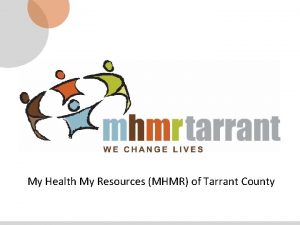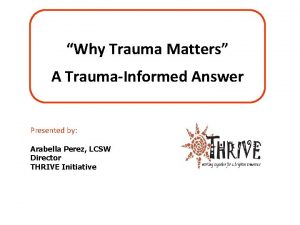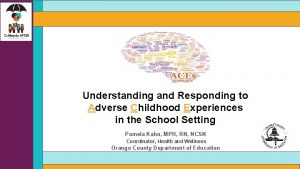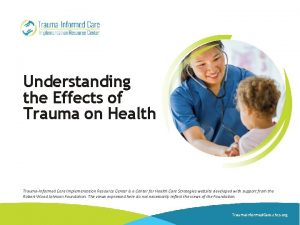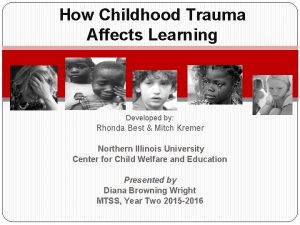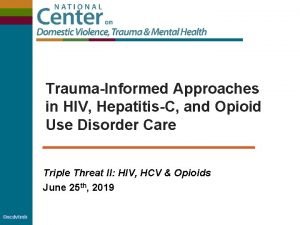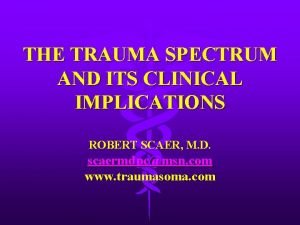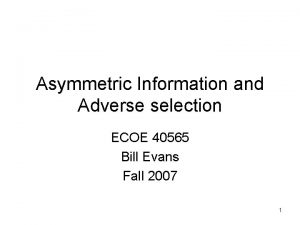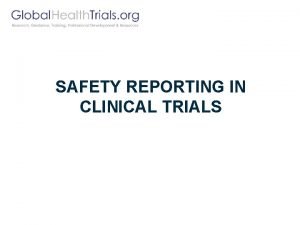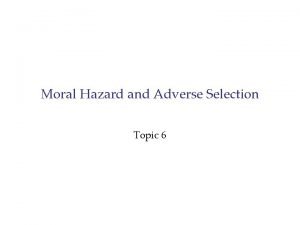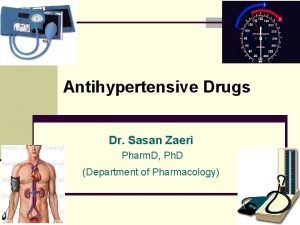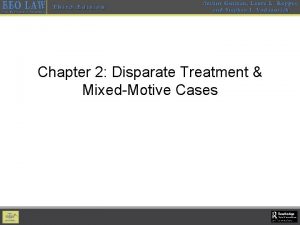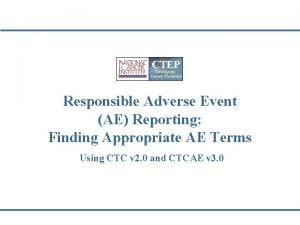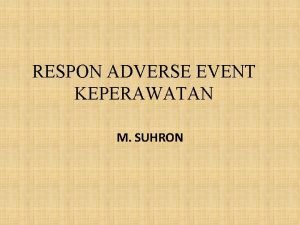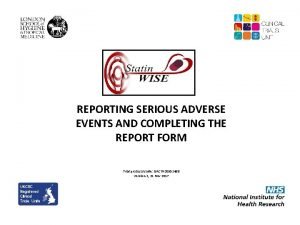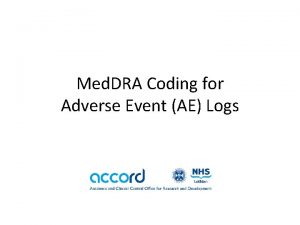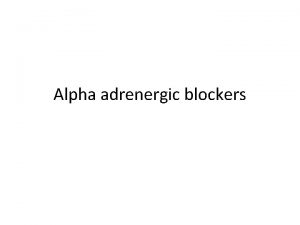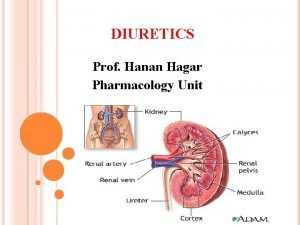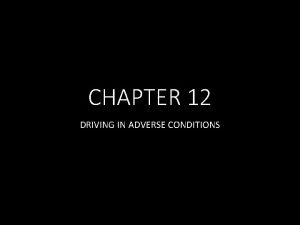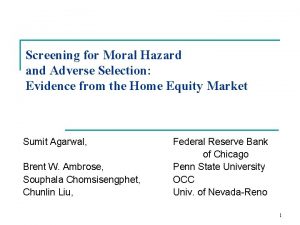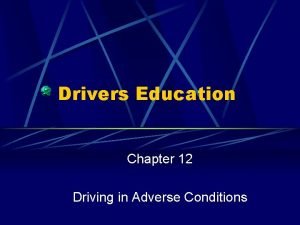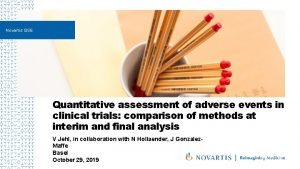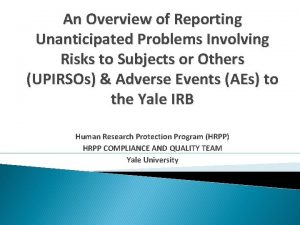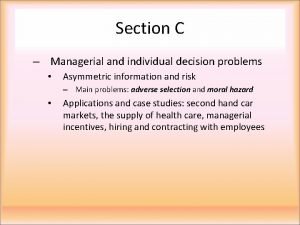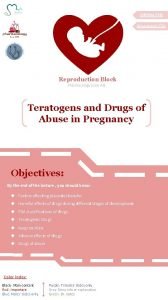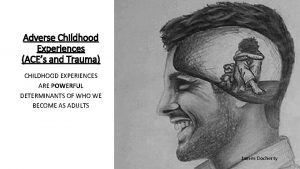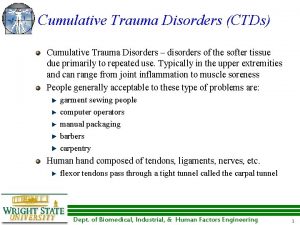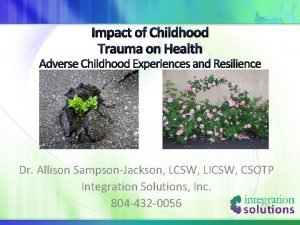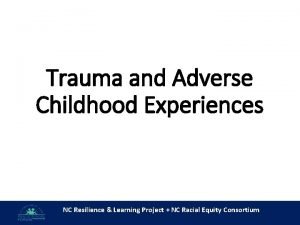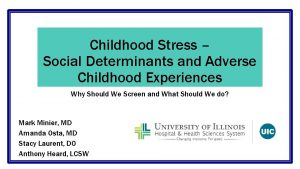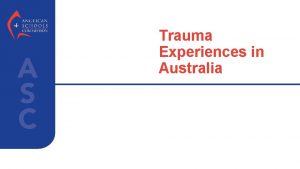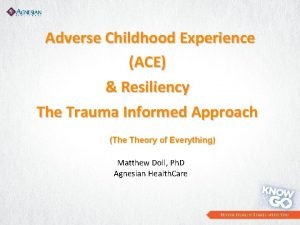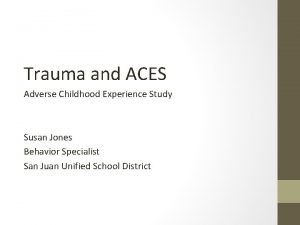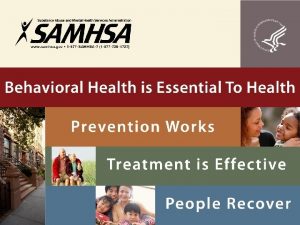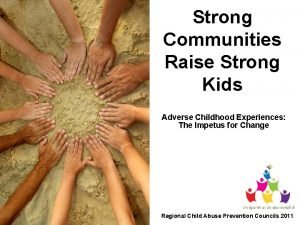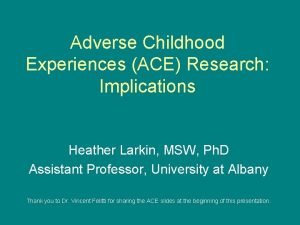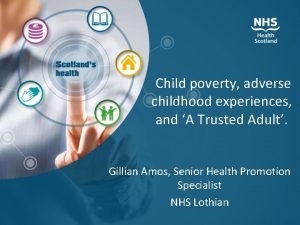The Trauma Spectrum Cumulative adverse experiences since childhood

















![Using EMD/R with Children [Precautions] • Children between the ages of 8 and 12 Using EMD/R with Children [Precautions] • Children between the ages of 8 and 12](https://slidetodoc.com/presentation_image/5d2127e529426f40e9ed66f7d3eaaabc/image-18.jpg)
![Using EMD/R with Children [Precautions] • Use EMD/R in small doses, interweaving other positive Using EMD/R with Children [Precautions] • Use EMD/R in small doses, interweaving other positive](https://slidetodoc.com/presentation_image/5d2127e529426f40e9ed66f7d3eaaabc/image-19.jpg)























- Slides: 42

The Trauma Spectrum Cumulative adverse experiences since childhood create vulnerability: • • • Adverse childhood events Neglect & insecure home life Secondary trauma-impact of observation Out of control high levels of stress Culturally endorsed trauma

The Trauma Spectrum (con’t. ) Some research suggests that people who experience “normal” stresses like illness, divorce, bereavement, or job loss develop PTSD symptoms at the same rate as those who undergo traumatic stress. A romantic breakup or the anticipated death of a relative may not be traumatic by DSM-IV-TR standards but those who experience them report as much distress as those who suffer a catastrophic trauma. (Harvard Mental Health Letter, Aug 2007)

Why Stress & Trauma Impacts Us Differently Cumulative Adverse Experiences since childhood create vulnerabilities that combine with Traumatic Events of adolescence and adulthood The Trauma Lifestyle To create pathways for Post. Trauma Conditions emotionally and medically

How Stress &Trauma Affect the Brain and the Brain Affects Everything Else The brain has three basic parts in a bottom-up design (triune brain): 1. Action: “primitive brain” brain stem (automatic functions) 2. Emotion: “survival brain” limbic system (emotional brain) 3. Thought: “higher brain” cortex § The Primitive & Survival Brain tend to override the Cerebral Cortex. (Prepotency) § HPA Axis = Hypothalmus-Pituitary-Adrenals (Scaer, 2001, The Body Bears the Burden)

Stress & Trauma (con’t. ) Perpetual High Levels of Adrenalin: Like having a car in drive, with the accelerator and brake to the floor. The major organ systems of the body wear out Chronic fatigue and chronic pain sets in The survivor’s long term ability to function is undermined. Depression is frequently a corollary.

Adverse Childhood Experience ACE Study (see Felitti 1998) A strong and consistent relationship between level of exposure of childhood emotional, physical or sexual abuse, and household dysfunction and. . . Adult health risk behavior and disease in adulthood Multiple categories of trauma exposure create multiple risk factors later in life and lead to early death. Childhood traumas are one of the basic causes of disease and death in adult life.


The Stress & Trauma Core can have many different “heads”

Treatment & Self-Care Learn to access, develop, and utilize inner resources and strengths. Goal: Learn to use 2 principles: 1) The same strengths required to survive traumatic experiences can be used to overcome the effects of the trauma. 2) You have other strengths within yourself to progress. Remove the barriers to accessing survival & progressive strengths.

Treatment & Self Care Discovering Personal Strengths As a child I dreamed: My dream now is: My childhood strengths were (artistic ability, sense of humor, sensitivity, etc. ) My strengths now are: I felt happy when: I felt strong when: Three things that mattered most to me in the past are: As a child, when I was sad or upset I turned to: A parent A sibling A peer A teacher A grandparent A neighbor/Family Friend Member of my religious faith Kept to myself The family pet A toy or object T. V. Other Before 16, I felt the most comfort from involvement with: People Animals Nature God Art Reading Dance Music Writing Athletics Other

Treatment & Self-Care • Compassion fatigue is the physical, emotional, and spiritual exhaustion, and subsequent symptoms that come from that exhaustion, that result from us passionately and compassionately giving our care, our emotional and spiritual energy, and resources to others.

Treatment & Self-Care Recommendations • Awareness: Numbness, resentment, flulike symptoms, fatigue, loss of interests. • Self-Knowledge & Honesty: You are not invincible. You have limits. Selfacceptance. We ALL have limits. • Interpersonal Connections: Genuine interactions in a safe environment. • Nature Connections: “First be a good animal. ” Emerson

Treatment & Self-Care Recommendations • Balance: Remember the organization of the brain: Primitive-Emotional-Cognitive or [Physical]-[Social & Emotional] -[Mental & Spiritual] Remember your roots. Many of the best things you can do to protect yourself from burnout you did in some form as a child and adolescent.


EFT Continued • Try it on just about anything: Emotional Problems, Physical Problems, Overcoming Unhealthy Cravings, Changing bad habits. • For detailed training go to http: //emofree. com/ to download a free manual and sign up for a weekly newsletter.

Treatment and Self-Care Recommendations Come to Your Senses • Bridging is being in the moment and connecting with your senses in a way that quiets the mind. As you bridge, your awareness expands since you are getting away from your busy and distracting mind. • As you learn to bridge you can neutralize your “Identity System” which contains worry, clutter and noise. (Block, 2005, Come to Your Senses)

EMD/R is an Important Tool for Resolution of an Event of Trauma • What is it? Client holds upsetting memory material in mind while following a rhythmic set of eye movements. • This process of eye movements or (other rhythmical stimuli) accelerate the processing of that material. • Dr. Shapiro stresses EMD/R should be done by a licensed, EMD/R trained MHP.
![Using EMDR with Children Precautions Children between the ages of 8 and 12 Using EMD/R with Children [Precautions] • Children between the ages of 8 and 12](https://slidetodoc.com/presentation_image/5d2127e529426f40e9ed66f7d3eaaabc/image-18.jpg)
Using EMD/R with Children [Precautions] • Children between the ages of 8 and 12 handle EMD/R readily. • The younger the child the more the clinician needs to be cautious not to retraumatize the child. • With children 5 to 8, more time needs to be taken to build a safe relationship, with greater reliance on safe place & selfesteem building with EMD/R
![Using EMDR with Children Precautions Use EMDR in small doses interweaving other positive Using EMD/R with Children [Precautions] • Use EMD/R in small doses, interweaving other positive](https://slidetodoc.com/presentation_image/5d2127e529426f40e9ed66f7d3eaaabc/image-19.jpg)
Using EMD/R with Children [Precautions] • Use EMD/R in small doses, interweaving other positive activities with units of trauma exposure. • “Reprocessing” is the positive aspect of trauma resolution. Use positive targets in the process. • Remember the 3 phases of trauma treatment: Safety-Resolution-Connection. If the child is not safe in his/her current situation trauma resolution must proceed with great caution, if at all. (Tinker & Wilson, Through the Eyes of a Child, EMD/R with Children)

The 8 Phases of the EMD/R Comprehensive Tx Plan 1. Client history and tx planning. Most disturbing experiences, symptoms, and triggers are targeted. Coping skills to be learned are also part of tx plan. 2. Preparation. Therapeutic relationship of trust. EMD/R theory, procedures and expectations explained. Self-relaxation taught to cope w/ distressing arousal.

8 Phases of EMD/R (con’t) 3. Assessment Identify aspects of the target to process that best represent the traumatic memory. Identify a negative belief about self associated with event. Identify negative emotions & physical sensations. Using SUDS (1 -10) rate degree of distress.

8 Phases of EMD/R (con’t) 4. Desensitization. Think of targeted material (i. e. , image, negative belief, disturbing feelings and sensations). While holding this in mind do a set of eye movements by following two fingers on therapist’s hand, held abt 12 inches away and moved rhythmically back and forth across the field of vision. Processing begins, & new mental material emerges.

8 Phases of EMD/R (con’t) 5. Installing and Strengthening the Positive Cognition. When distress has been sufficiently reduced, the positive cognition is repeated, such as, “When you think abt the original incident how do the words ‘I did my best’ (for eg. ) feel now? ” The positive cognition is reinforced w/ additional sets of eye movements until it feels sufficiently valid by client.

8 Phases of EMD/R (con’t) 6. Body Scan. To further ensure that all aspects of a traumatic memory have been processed, the client is then asked to notice if any disturbing physical sensations remain as she brings up the target. If so, that sensation is targeted for reprocessing with additional eye movements.

8 Phases of EMD/R (con’t) 7. Closure. Help the client leave the session feeling safe, even if processing is not complete. Self-calming strategies are done (refer back to #2 – Preparation), and the client is advised that processing will likely continue between sessions. Client is instructed to use a journal to record the processing and calming used to contain arousal.

8 Phases of EMD/R (con’t) 8. Reevaluation. At the beginning of the next session, the clinician ascertains if positive results have been maintained from the last session. New targets are identified, or old targets that still need processing are identified and processed. (Shapiro, Francine, EMD/R Basic and Intermediate Training; 1995, Eye Movement Desensitization & Reprocessing, Basic Principles, Protocols and Procedures, Guildford Press)

Strengths of EMD/R • EMD/R often leads to rapid improvements • EMD/R processes various aspects of traumatic memories together: cognitions, (thoughts/images), feelings, physical sensations, and behaviors related to the troubling memories. Different aspects of memory is facilitated. • Control remains with the client.

Strengths of EMD/R (con’t) • EMD/R diffuses and clears out aspects of memory networks that might be related to a traumatic memory. • The benefits of processing one type of memory may generalize to other similar memories. For multiple or repeated trauma, similar traumas may be grouped together. Processing a representative incident from each group may neutralize other incidents in that group.

Strengths of EMD/R • Traumatic memories need not be discussed in detail. • Treatment can be efficient, making EMD/R useful for individuals and for disasters affecting many people. (The Post-Traumatic Stress Disorder Sourcebook, 2 nd Ed. , Schiraldi, Glenn R. )

Why EMD/R Works • Dissociated memories will heal naturally once processing is stimulated. EMD/R helps people to confront, not avoid, disturbing memories, in small doses, in a controlled and safe way. • Eye movements may stimulate electrical connections between parts of the brain that process memories (REM sleep, high levels of trauma/emotion can freeze eye movements)

Why EMD/R Works • The client is taught they can step outside the memory and observe it with detachment. Disturbing memories are paired with neutral or comforting emotions, not fear. Concentrating on eye movements provides some distraction from the pain of distressing memories while processing occurs.

Why EMD/R Works • Breaking down a traumatic memory into its elements (i. e. , physical responses, emotions, images, etc. ) makes it possible for the client to see the incident in terms of its parts instead of its totality. This makes the traumatic memory less overwhelming.

Treatment Considerations Safety Resolution Connection Using the Safety-Resolution-Connection Model to provide structure, & using the triune brain as a guide, can convert surviving to progressing in treatment. (Refer to Treatment h. o. in back)

Treatment Considerations Following the Organization of the Brain (con’t. ) • Research by Charcot, Janet, and Freud demonstrates the powerful reality that trauma pain is stored in the sub-conscious. Research in recent years indicates trauma pain is stored throughout the body- e. g. , “tissue memory. ” • The Limbic System interfaces with the subconscious. Pain removal is more basic to healing than memory narration. The subconscious has many avenues for pain removal. • Research ego states, body memory, energy work.

Treatment Considerations CBT should generally follow trauma resolution methods It is more effective to resolve the Core of trauma before other interventions Trauma Tx Should not Depend on Language A trauma brain is right brain not left brain With the mid and primitive brains quieted the cerebral cortex is more receptive to change dysfunctional thinking.

Treatment Considerations Life Skill Enhancement Life skill enhancement in the physical realm promotes mental/emotional healing Traumatized children and adults need to have physical sensory experience to: 1. Unlock bodies 2. Activate effective fight/flight 3. Tolerate their sensations 4. Befriend their inner experiences 5. Activate new action patterns (rewire circuits)

Treatment Considerations Life Skill Enhancement (con’t. ) • • As part of the Life Skills Package remember NATURAL SEROTONIN (traumaawareness. org) Nutritious Food (Pratt, 2004, Superfoods) Nature Exercise Food for the Mind Connection w/ others through Helping Mini-Vacations (traumaawareness. org) Assert what Matters to You Keep a Journal

Treatment Considerations Always give the Client Hope “Have To’s” of life can become “Want To’s” When there is Hope

Review of Tx Considerations Phase 1: BRAIN STEM 1. Grounding 2. Cardio exercise to change biochemistry 3. Sensory experience to unlock bodies, tolerate sensations, Befriend inner experiences. 4. Use body to overcome powerlessness 5. Calm animal brain down-be in present 6. Purposeful action 7. Yoga and Meditation-major pathway to animal brain

Review of Tx Considerations Phase 2 MID-BRAIN Remember 2 types of trauma in the mid-brain/need two kinds of approaches: 1) Single incident-EMD/R, TFT. . . 2) Chronic Complex-Pain release via body work & subconscious Journaling-Narrative, Feelings, Sensory Details Art Therapy Learn to have a memory instead of being a memory

Review of Tx Considerations Phase 3 PREFRONTAL CORTEX • Cognitive Behavioral Therapy (CBT) • Use the human capacity to create a larger context and new realitiescreativity and reason • Challenge the neural grooves by seeking new experience

LIFE IS NOT ABOUT ACHIEVING IT’S ABOUT OVERCOMING
 Adverse childhood experiences study
Adverse childhood experiences study Adverse childhood experiences study
Adverse childhood experiences study Adverse childhood experiences study
Adverse childhood experiences study Slidetodoc.com
Slidetodoc.com Adverse childhood experiences study
Adverse childhood experiences study Childhood trauma discussion questions
Childhood trauma discussion questions Gabriela zapata alma
Gabriela zapata alma Childhood trauma test
Childhood trauma test Robert scaer
Robert scaer Middle childhood and adolescence
Middle childhood and adolescence Copper orbital diagram
Copper orbital diagram Absortpion
Absortpion Adverse reaction definition
Adverse reaction definition Adverse selection
Adverse selection Paracetamol dose child per kg
Paracetamol dose child per kg Serious adverse event reconciliation
Serious adverse event reconciliation Adverse reaction definition
Adverse reaction definition Adverse selection
Adverse selection Moa of alpha adrenergic blockers
Moa of alpha adrenergic blockers Furosemide side effects
Furosemide side effects Adverse treatment
Adverse treatment What is adverse selection
What is adverse selection Ahca adverse incident reporting
Ahca adverse incident reporting What does skid mean in driving
What does skid mean in driving Adverse event
Adverse event Adverse yaw
Adverse yaw Whats a sentinel event
Whats a sentinel event Adverse event adalah
Adverse event adalah Dpp4 inhibitor adverse effects
Dpp4 inhibitor adverse effects Adverse events in hospital
Adverse events in hospital Adverse food reactions
Adverse food reactions Adverse event log
Adverse event log Alpha blockers
Alpha blockers Diuretic drugs classification
Diuretic drugs classification To give yourself more time for the ipde process at night
To give yourself more time for the ipde process at night Effects of paracetamol
Effects of paracetamol Adverse selection
Adverse selection Overdriving headlights means
Overdriving headlights means Novartis adverse event reporting
Novartis adverse event reporting Unanticipated problem vs adverse event
Unanticipated problem vs adverse event Adverse selection
Adverse selection Drugs that don't cross placenta mnemonic
Drugs that don't cross placenta mnemonic Adverse selection
Adverse selection
